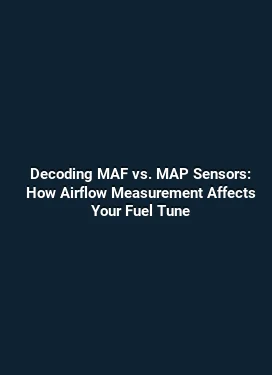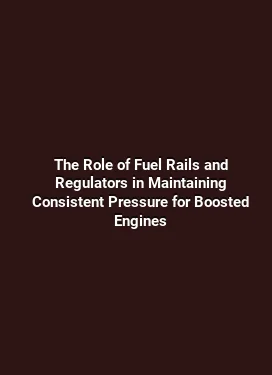Water-Methanol Injection and How It Cools Your Intake Charge
Water-methanol injection (WMI) is a controlled spray system that introduces a precise mixture of water and methanol into the intake tract of internal combustion engines. While the term may evoke a simple cooling idea, the underlying physics, chemistry, and engineering bring tangible benefits to performance, efficiency, and safety. This article delves into how WMI cools the intake charge, the mechanisms at play, the essential components, and practical considerations for enthusiasts and professionals working with modern intake and fuel systems.
Understanding the Core Concept: Why Cooling the Intake Charge Matters

In forced-induction engines, especially turbocharged and supercharged setups, the air entering the engine is compressed, which raises its temperature. A hotter intake charge reduces air density (less oxygen mass per cylinder), increases the tendency toward pre-ignition or detonation, and can limit the engine’s ability to safely push more boost. Cooling the intake charge increases air density, improves volumetric efficiency, and allows for more aggressive ignition timing and boost without compromising reliability. Water-methanol injection leverages two synergistic effects: rapid heat absorption through phase change and the chemical cooling provided by methanol vaporization.
How Water-Methanol Injection Cools the Intake Charge
Phase-Change Cooling: The Latent Heat Advantage

When water is sprayed into the intake, it rapidly absorbs energy as it changes phase from liquid to vapor. This phase change requires a significant amount of energy, known as latent heat, which is drawn from the surrounding air and intake components. The result is a pronounced drop in the temperature of the intake air, which translates to higher density without adding external cooling. Methanol contributes to this cooling as well because it has a lower boiling point and enhances the overall cooling performance of the spray plume.
Methanol’s Chemical Cooling and Anti-Knock Benefits
Methanol, a high-octane alcohol, has properties that help suppress detonation and pre-ignition in high-load conditions. As methanol vaporizes, it absorbs heat and also participates in a gentle dilution of the in-cylinder charge, which can delay the onset of knock. This allows for higher boost pressures and more aggressive timing maps while maintaining safe operation. In addition, methanol’s oxygen content (approximately 50% by weight) supports flame stability in the sprayed region when proper delivery is maintained, though modern systems are designed to avoid unintended leaning or overly rich conditions.
Key Components and How They Integrate with Intake & Fuel Systems
A typical WMI system comprises a reservoir, a pump, a control unit, injectors/nozzles, lines, and a spray nozzle positioned to deliver into the intake tract. The precise arrangement depends on the engine architecture, the expected operating range, and the desired spray characteristics. The following elements form the core of a robust WMI installation:
Reservoir and Pump
The reservoir stores the water-methanol blend, typically in a ratio ranging from pure water to methanol-rich mixtures depending on performance goals and safety considerations. A dedicated pump ensures consistent delivery even under high vacuum or variable manifold pressure. The pump size and head pressure influence spray accuracy at different RPMs and boost levels.
Control System and Sensing
Advanced controllers monitor critical parameters such as boost pressure, manifold air temperature, intake air temperature, fuel pressure, and sometimes engine load. The control logic modulates spray duration and frequency to maintain the target effect across the RPM range. Some systems integrate with engine management platforms to coordinate WMI operation with timing, fueling, and boost control, creating a harmonized performance profile.
Nozzles and Spray Pattern
Nozzle design determines spray droplet size, distribution, and reach. Finer droplets offer rapid evaporation and more efficient cooling but require careful matching to pump pressure and line diameter to avoid clogging or puddling. Spray location is critical: introducing the blend upstream of the intercooler or within the intake tract just after the turbocharger is common practice, but each layout has trade-offs related to heat soak, spray efficiency, and aerosol dispersion.
Delivery Timing and Injection Strategy
Timing varies with engine speed and load. Some systems operate on a fixed schedule, while others adapt to real-time data such as manifold pressure or charge temperature. The strategy can be conservative to protect the engine during cold starts and high-altitude conditions or aggressive to maximize returns at peak power. The goal is to deliver the cooling effect when charge temperatures pose the most risk without disrupting fuel-air balance during other operating phases.
Practical Benefits: Performance, Efficiency, and Durability
WMI offers a mix of tangible and nuanced gains that become apparent across a variety of driving scenarios. The following benefits are well-documented by tuners and supported by fluid dynamics principles:
Increased Charge Density and Power Potential
Lower intake temperatures raise air density, enabling more oxygen to be packed into each cylinder. This supports higher boost levels and more aggressive ignition timing, often resulting in measurable horsepower gains, especially in turbocharged or supercharged applications. Real-world testing frequently shows improvements in horsepower and torque curves at higher RPM where heat soak is more pronounced.
Detonation Suppression and Knock Mitigation
By cooling the charge and slightly enriching the charge with methanol, WMI reduces the propensity for detonation under boost. This creates a safety margin that allows a tuner to explore more aggressive ignition timing or increased boost pressure, particularly in engines with higher compression or those operating with ethanol blends where knock resistance is already a factor.
Boost Gain with Conservative Tuning
For stock or near-stock engines, WMI can offer noticeable benefits without major engine modification. The system is often positioned as a complementary cooling and anti-knock technology that preserves reliability while delivering incremental power, especially in hot climates or sustained high-load driving such as track days or towing scenarios.
Installation Considerations: Tuning, Safety, and Reliability
Implementing WMI successfully requires careful planning around fuel delivery, ignition strategy, and cooling needs. The following practical considerations help ensure a reliable installation and predictable performance gains:
Blend Ratio and Safety
Choosing the right water-to-methanol ratio is engine- and goal-dependent. A higher methanol content can improve cooling but increases flammability and potential material compatibility concerns. Most setups start with a conservative blend and adjust based on temperature data, knock resistance, and driveability. Safety features such as automatic shut-off on loss of system pressure or during cold starts are essential to prevent unintended spray during engine warm-up or malfunction.
System Integration with Fuel Management
WMI should be integrated with the vehicle’s fuel and ignition systems to avoid unbalanced conditions. In some configurations, the methanol contributes to an enriched mixture by virtue of its oxygen content, which can demand calibration adjustments to maintain stoichiometry. Modern engine management platforms allow for real-time monitoring and compensation, ensuring the air-fuel ratio remains within safe operating windows across the RPM spectrum.
Line Sizing, Routing, and Heat Management
Appropriate tubing diameter and routing minimize spray losses and ensure consistent delivery at high RPM. Lines should be secured to withstand vibration and heat from the engine bay. On vehicles with aggressive thermal cycling, heat shields or insulated routing can prevent premature evaporation and maintain spray efficiency. Regular inspection for cracks or leaks is a practical habit for long-term reliability.
Maintenance and Diagnostics
Routine checks include monitoring reservoir level, pump operation, nozzle cleanliness, and sensor calibration. Fuel trims, ignition timing, and boost pressure data from the ECU or data logger help diagnose drift in spray behavior. A well-documented data history supports accurate tuning decisions and helps identify correlations between WMI activity and performance gains or safety events.
Optimization Strategies: From Patrol to Peak Performance
For enthusiasts seeking to optimize WMI performance, several approaches can help translate theory into measurable outcomes. The emphasis is on data-driven tuning, system reliability, and real-world testing under varied loads and temperatures.
Empirical Tuning with Temperature Targets
Setting target charge temperature reductions at different boost levels provides a framework for iterative tuning. Track temperature reductions at WOT (wide-open throttle) and observe power curves, ensuring gains align with safer knock margins. Documenting ambient conditions and time-of-day variations helps interpret data accurately when evaluating results.
Synergy with Intercooling and Fuel Stretch
WMI often complements intercooling by providing additional cooling where the intercooler may be less effective due to heat soak or limited airflow. In engines running ethanol or methanol blends, calibration must account for fuel energy density changes and potential shifts in volumetric efficiency. Strategic timing of WMI during peak load can maximize gains without compromising cold starts or drivability.
Common Myths vs. Real-World Realities
As with any performance modification, several misconceptions can cloud judgment. Here are some practical clarifications based on field experience and engineering fundamentals:
Myth: WMI Always Increases Power Across the Board
Reality: Gains are most pronounced under high-boost, high-temperature conditions where intake air is densest and detonation risk is highest. In mild conditions or naturally aspirated engines, the benefits may be modest or require specific tuning to become noticeable.
Myth: Any Methanol Blend is Safe for All Engines
Reality: Material compatibility and fuel system design matter. Some seals, hoses, and coatings may not tolerate methanol well over time. A carefully designed system with compatible components, proper ventilation, and proper handling mitigates risks.
Myth: WMI Replaces a Proper Intercooler
Reality: WMI is a supplementary tool. It can reduce charge temperature beyond what basic intercooling achieves, but it does not negate the benefits of a well-designed intercooler, adequate cooling airflow, or proper engine cooling systems.
Performance Verification: How to Test and Validate
Validating WMI performance involves a combination of data collection, controlled testing, and reproducible measurements. The following practices help ensure credible results:
Baseline and Post-Installation Comparisons
Record baseline data for temperatures, air-fuel ratio behavior, and power outputs before installing WMI. After installation, replicate the same testing scenarios to quantify improvements and identify any drift in fueling or timing.
On-Track Data Logging and Safety Margins
Utilize data logging to monitor knock events, cylinder pressure if available, and fuel trims. Establish safety margins that prevent unintended lean conditions or excessive methanol exposure under prolonged boost or high-speed runs.
Long-Term Reliability Observations
Track system performance over multiple heat cycles and driving conditions to assess the durability of spray components. Observing for leaks, nozzle clogging, or pressure drops over time informs maintenance schedules and potential design refinements.
Conclusion: A Practical Tool in the Performance Toolbox
Water-methanol injection represents a disciplined approach to managing intake charge temperatures, enabling higher performance envelopes without resorting to extreme modifications. By combining phase-change cooling with methanol’s chemical effects, WMI complements modern intake and fuel systems to deliver tangible gains in power, throttle response, and safety margins under demanding conditions. The key to success lies in a well-mared integration: appropriate blend ratios, precise control strategies, reliable hardware, and thoughtful tuning that respects the interaction between cooling, fueling, and ignition dynamics.






